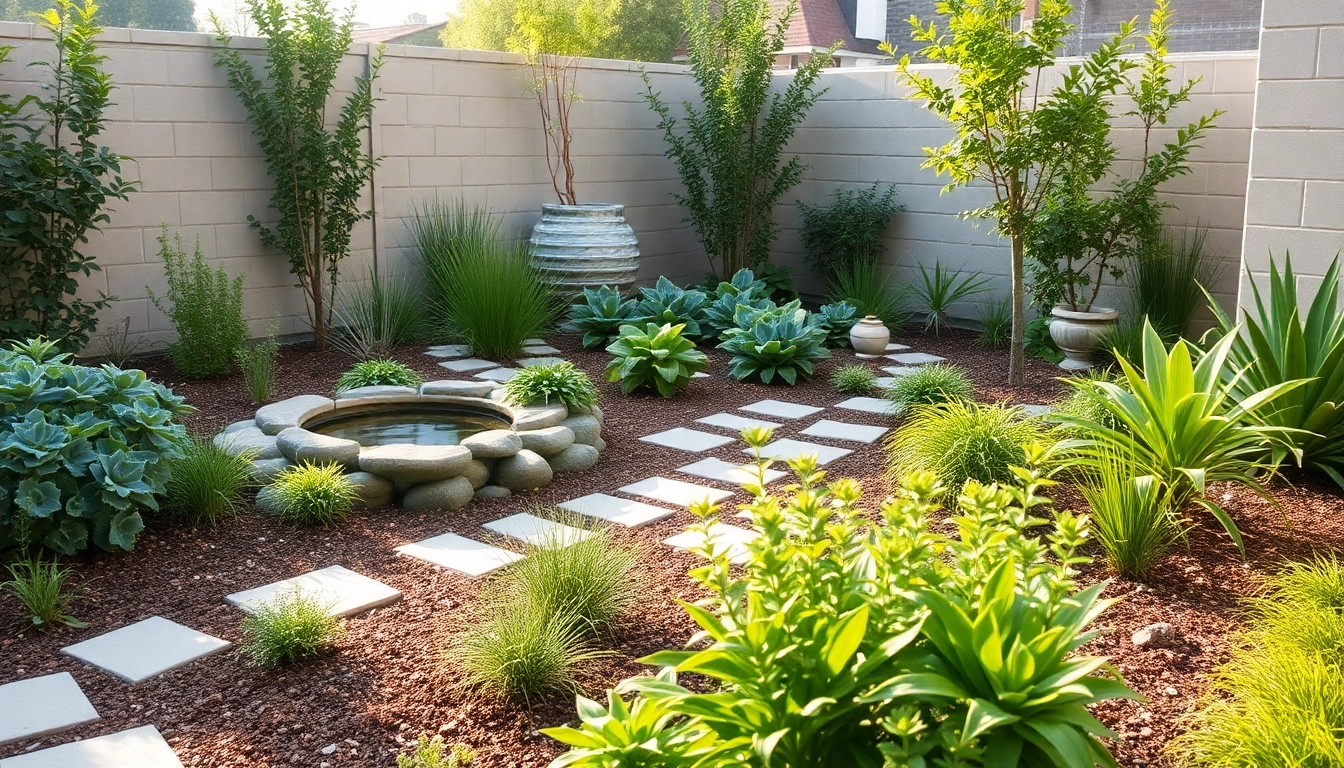
Elevate Your Outdoors: Professional Landscape Design Services for Every Home
Understanding Landscape Design Services
What Is Landscape Design?
Landscape design is a multifaceted profession that combines art, science, and environmental stewardship. At its core, landscape design involves the strategic planning and organization of outdoor spaces to enhance their aesthetic appeal, functionality, and sustainability. Landscape designers work with various elements, including plants, soil, structures, and water features, to create cohesive and inviting environments, whether for residential, commercial, or public spaces. The process typically begins with an analysis of the space, considering factors such as the climate, soil conditions, elevation, and existing infrastructure. A professional landscape design service will also take into account a client’s preferences and lifestyle to ensure that the final design aligns perfectly with user needs.
Benefits of Professional Landscape Design Services
Engaging a professional landscape design service offers numerous advantages that go beyond simple aesthetics. Here are some of the key benefits:
- Expertise and Knowledge: Landscape designers bring specialized training and experience, allowing them to identify the best plants, materials, and design principles suitable for your specific environment.
- Creativity and Vision: Professionals can envision possibilities that you might not have considered, transforming ordinary spaces into extraordinary landscapes.
- Saves Time and Effort: Designing a landscape takes significant time and effort. By outsourcing this task, you can focus on other important aspects while trusting professionals to handle the details.
- Increased Property Value: A well-designed landscape can boost the market value of your property, attracting potential buyers and significantly enhancing curb appeal.
- Environmental Stewardship: Professional designers are skilled in creating landscapes that are not only beautiful but also sustainable, incorporating native plants and efficient water management techniques that support local ecosystems.
Common Myths About Landscape Designers
Despite the obvious advantages, many misconceptions about landscape designers persist. Addressing these myths is crucial for homeowners considering landscape design services:
- Myth 1: Landscape designers are only for large projects.
- Myth 2: DIY landscaping is just as effective as hiring a professional.
- Myth 3: Landscape design is purely aesthetic and does not consider functionality.
- Myth 4: Hiring a landscape designer is too expensive.
In reality, landscape design services can be customized to fit projects of any size and budget. Additionally, professional designers ensure that aesthetics and functionality go hand in hand, creating spaces that are not only beautiful but also practical for everyday use.
Key Elements of Effective Landscape Design
Essential Features to Consider
Effective landscape design incorporates several essential features, each adding value and purpose to the overall composition. Below are key elements to consider:
- Space Planning: Understanding how different areas of the landscape will be used is vital. Designers can create functional zones for recreation, dining, gardening, and relaxation.
- Focal Points: Incorporating focal points such as sculptures, water features, or distinctive trees helps draw the eye and create visual interest.
- Pathways and Accessibility: Well-planned pathways promote ease of movement throughout the landscape, ensuring accessibility for all individuals and encouraging exploration.
- Lighting: Proper lighting not only enhances night-time beauty but also improves safety and usability in outdoor spaces.
- Soil Management: Quality soil is critical for plant success; therefore, landscape designers often assess soil conditions and recommend necessary amendments.
Choosing the Right Plants for Your Space
One of the most crucial aspects of landscape design is selecting the appropriate plants. Consider the following factors when choosing plants:
- Climate Zone: Understand your local climate and select plants that thrive in those conditions.
- Soil Type: Different plants have varying soil requirements. A soil analysis can assist in selecting the right species.
- Maintenance Level: Assess how much time and effort you are willing to dedicate to maintaining your garden. Some plants require more care than others.
- Aesthetic Appeal: Choose plants that complement each other in terms of color, texture, and size for visual harmony.
- Seasonal Interest: Consider plants that provide year-round appeal through blooms, foliage, or structure.
Incorporating Hardscape in Your Landscape Design
Hardscape elements like patios, walls, pathways, and decks provide structure and functionality to landscape design. When integrating hardscape features, consider:
- Material Selection: Choose materials that complement the landscape and existing architecture.
- Drainage Solutions: Ensure that hardscapes allow for proper water drainage to avoid flooding and damage to plants.
- Durability: Select materials that can withstand weather conditions and require minimal maintenance.
- Design Integration: Ensure that hardscape elements harmonize with plant selections and overall design philosophy.
How to Choose the Right Landscape Design Service
Evaluating Experience and Credentials
When selecting a landscape design service, evaluating the experience and qualifications of the designers is essential. Look for:
- Certifications: Credentials from recognized organizations such as the American Society of Landscape Architects (ASLA) ensure proficiency.
- Portfolio: Review previous projects to gauge the designer’s style and capabilities.
- Client Testimonials: Seek feedback from past clients to assess satisfaction and professionalism.
Understanding Design Styles and Specializations
Landscape designers often specialize in particular styles or project types. Familiarize yourself with various landscaping styles, including:
- Modern: Characterized by minimalism and clean lines, enhancing architectural elements.
- Traditional: Incorporates classic plantings and structured garden beds to evoke a timeless appeal.
- Sustainable: Focuses on eco-friendly practices, using native plants and promoting biodiversity.
- Xeriscaping: Emphasizes drought-resistant plants and efficient water use for arid climates.
Interview Questions for Landscape Designers
When meeting potential landscape designers, ask pertinent questions that will help you evaluate their fit for your project:
- What is your design process?
- How do you approach sustainability in your projects?
- Can you provide references or examples of similar projects?
- What challenges have you faced in previous designs, and how did you overcome them?
- What is your approach to communication during the design and implementation phases?
Implementing Your Landscape Design
Steps to a Successful Landscape Installation
Implementing a landscape design effectively involves several key steps to ensure the project unfolds smoothly:
- Pre-Installation Planning: Finalize design details and conduct a site assessment to identify any potential challenges.
- Preparation: Clear existing vegetation and debris, and prepare the site for new elements according to the design plan.
- Installation: Begin with hardscape features, followed by planting beds, and finally, the plants themselves.
- Post-Installation Review: Evaluate the completed project to ensure all elements have been executed as intended.
Budgeting for Your Landscape Design Project
Creating a realistic budget is crucial for your landscaping project. Key considerations include:
- Initial Design Costs: Factor in the fees of hiring a landscape designer, as well as any materials needed for the design phase.
- Material Costs: Estimate costs for plants, soil, hardscape materials, and installation labor.
- Ongoing Maintenance: Allocate funds for regular upkeep, including watering, pruning, and fertilizing.
- Contingency Fund: Set aside extra funds for unexpected expenses during the installation or maintenance phases.
Maintaining Your Landscape Post-Installation
Once your landscape is installed, ongoing maintenance is vital for preserving its beauty and health:
- Watering: Ensure that plants receive adequate moisture, particularly during dry spells.
- Pruning: Regularly prune plants to encourage growth and maintain shape.
- Pest and Disease Management: Monitor for signs of issues and address them promptly with appropriate measures.
- Seasonal Care: Adjust care practices seasonally, such as mulching in winter or preparing plants for summer heat.
Measuring Success: Performance Metrics in Landscape Design
Assessing Visual Appeal and Functionality
The success of a landscape design project can be gauged through various performance metrics:
- Aesthetic Evaluation: Periodic assessments of the landscape’s beauty, color, and design coherence.
- Usage Analysis: Observing how well the space is utilized by residents and visitors, and whether it meets functional requirements.
Impact on Property Value
A professionally designed landscape can significantly increase property value. Metrics to consider include:
- Market Trends: Analyzing the increase in property value compared to homes with no landscaping.
- Return on Investment: Evaluating the financial returns when selling the property post-landscape installation.
Feedback and Client Satisfaction Surveys
Gathering client feedback is invaluable for assessing the overall success of a landscape design service:
- Surveys: Conducting client satisfaction surveys post-installation to gain insights into their experience and perspectives.
- Ongoing Communication: Maintaining contact with clients for long-term feedback, which can help improve service offerings.
